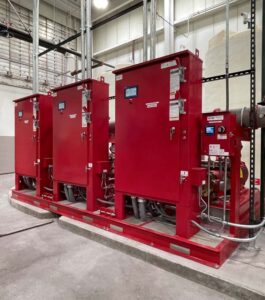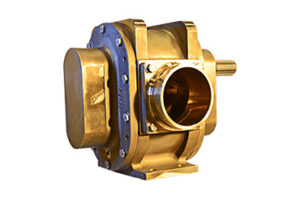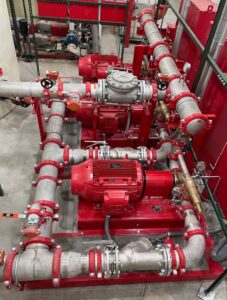Challenge of a Changing Industry
New environmentally friendly fire-fighting foam concentrates provide new challenges within the fire suppression industry. Fire system engineers are beginning the extensive process of redesigning fixed foam systems to accommodate the qualities of the new foams and regulations. Every aspect of the system must be considered, tested, and reviewed to ensure the system will perform as designed.
Redesigning for the Future

Recently, the airline industry experienced its first significant switch from Aqueous Film-Forming Foam (AFFF) to Synthetic Fluorine Free Foam (SFFF) firefighting foam concentrate at
Picture 1. Skid Mounted Foam Pump ControllersDenver International Airport. A major US airline converted one of its maintenance hangars to SFFF foam concentrate utilizing the existing sprinkler system. The airline hired a reputable fire protection engineering firm to lead the design team in completing a firefighting foam fixed system redesign of this magnitude. The engineering firm, aware of Fire Lion Global’s knowledge and experience, contacted us in the beginning stages of the project for assistance with the fixed foam system design and the required foam pump equipment. As a trusted partner, Fire Lion Global has provided UL/FM pumps and pump skid systems to many customers and various end users around the globe. This would be one of the largest projects Fire Lion Global has ever co-engineered, manufactured and installed. The hanger foam pump room area had space limitations; this would not allow the new pump system to ship as a single unit. To address this, Fire Lion Global engineers designed the skid in three sections to easily ship, assemble, and install it on-site in a critically small space.
The details of this system would require a quantity of three of our second-largest FM-approved pumps installed on a common base frame skid, with two of them running in parallel during any event. Per the requirements of NFPA 409, a third pump must also be installed as a backup in case any single pump does not operate or must be taken out of service. This system requires a system flow rate of just over 600 gpm with a pump discharge pressure rating of 247 psi. Because of the length of the foam concentrate line, per NFPA 409, a foam jockey pump is required to be installed. Unlike traditional centrifugal jockey pumps, the jockey pump required a positive displacement gear pump. We engineered this pump with the UL-listed jockey pump controller to the skid design. The UL/FM foam pump controllers (Picture 1) were required to be a Soft Start type controller as the inrush current needed to be limited. The controllers also contained automatic transfer switches if the backup power (onsite generators) needed to be used.
The foam pump skid has a concentrate line routed back to the storage tanks. The return line has a magnetic flow meter designed into the system. This type of flow meter is required per NFPA 20 to test the pump output during NFPA maintenance and testing cycles. A magnetic flow meter is the only accurate type of flow meter that should be used with foam concentrates in foam.
NFPA 20 & Net Positive Suction Head

One of the major items to consider with any pump system, especially with the new SFFF foam concentrates on the market today, is the Net Positive (Picture 3). Strategic Stainless Steel Piping Design.Suction Head (NPSH) that is available with the system design. Per NFPA 20, the NPSH available must be at least 5’ higher than the NPSH that is required for the pump to operate without cavitation. With the foam agent selected and the very high flow rate requirement mandating pumps running in parallel (Picture 2), Fire Lion Global engineering staff designed the skid solution to meet the NFPA 20 requirement. As you can see from (Picture 3), the suction piping design required 8” suction connections and a design to allow for minimum travel distance from the storage tanks to any pump running.

The suction piping design and the NPSH calculation must also consider the strainer baskets. With these higher-viscous liquids, the strainer baskets should have a hole size of ¼” (6.35 mm) or larger. Hole sizes, any smaller, will create higher friction losses in the system and could cause cavitation during the pumps’ operation. The use of eccentric reducers is also a major design consideration to maintain laminar flow in the system.
Our Commitment
NFPA 20 requires the startup of any pump system to be performed by the manufacturer or by a trained and authorized factory representative. Being trained and authorized by not only the pump company, but also the controller manufacturer, is a key component to maintaining the quality and lifespan of the product. Fire Lion Global was onsite during the startup to ensure the pump skid was performing per project specifications, end user requirements and regulations. Having the right team involved throughout the entire project ensures a safe reliable system. Fire Lion Global fully supports its customers from engineering design, during manufacturing, to final project commissioning.
With Fire Lion Global, you can discover the best pumps, skids, and systems to solve all your fire suppression challenges.
Contact us now, and let us guide you to the ideal product for your challenging application.

